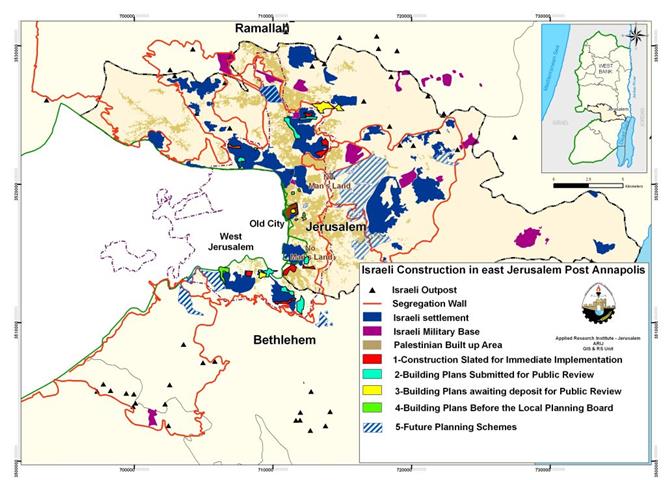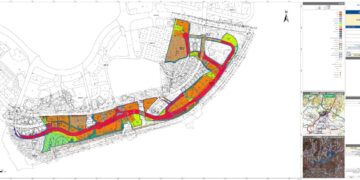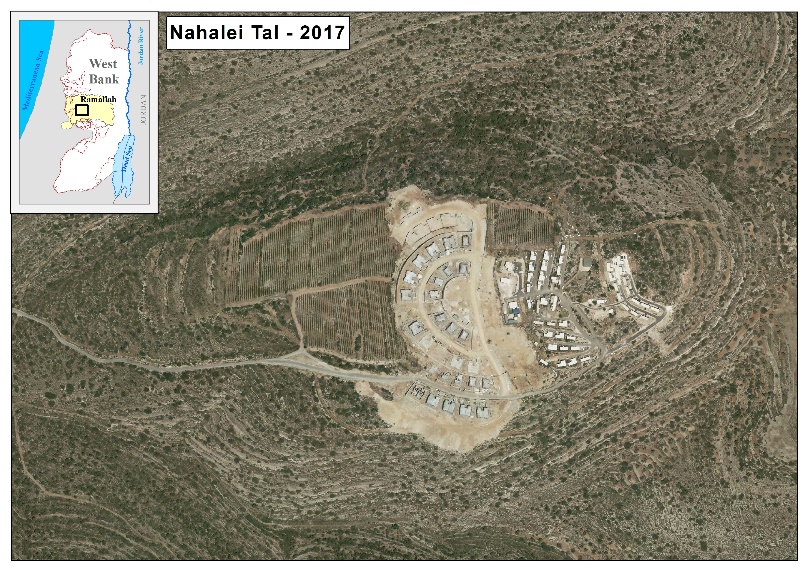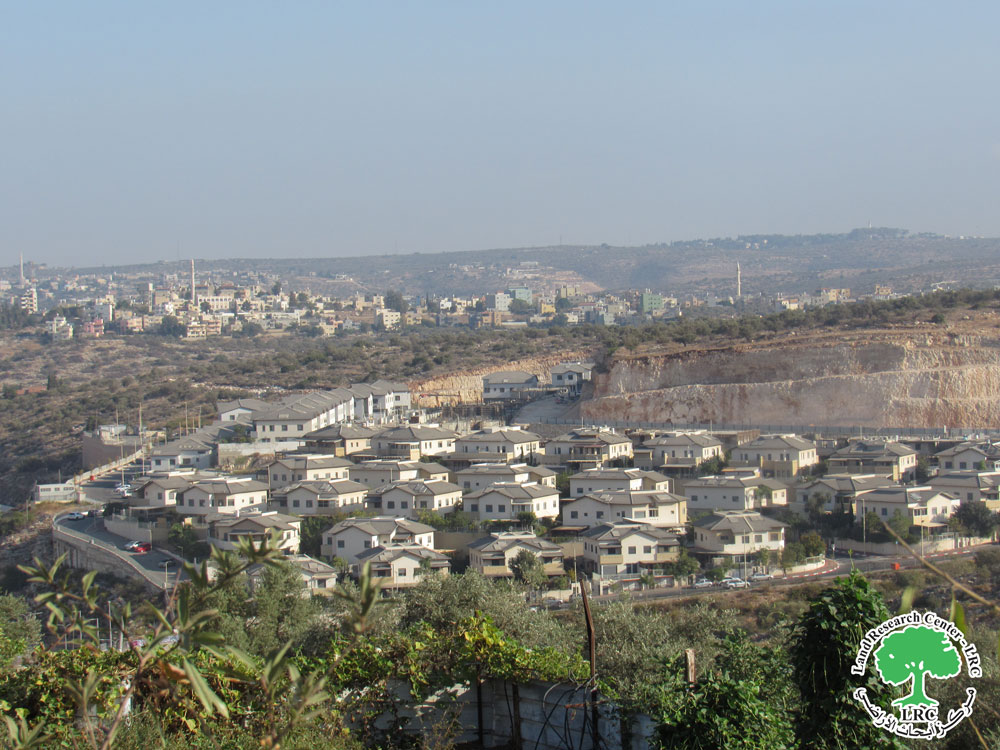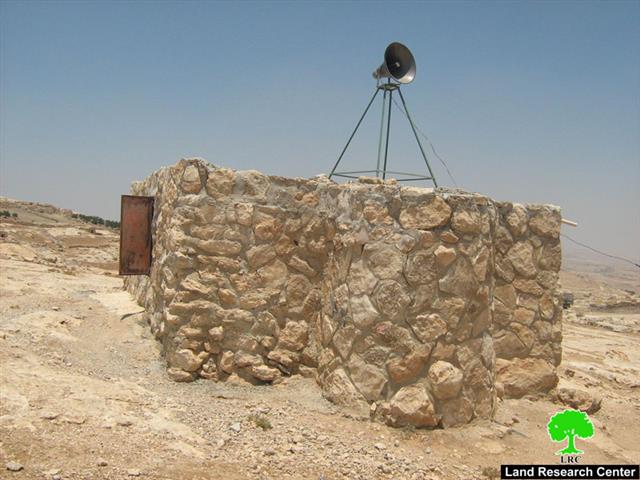In the months to follow Annapolis conference, which was held on the 26th of November 2007, in the United States of America, several statements and declarations were announced either by the Israeli Municipality of Jerusalem city or by the Israeli Ministry of Housing & Construction, which included bids and plans to add thousands of housing units to Israeli settlements in the occupied West Bank and most of them were in settlements within the city of Jerusalem. It is clear from these statementsthat Israel is not willing to include Jerusalem within any Final Status negotiations as according to the road map, which 'obligates Israel to freeze settlement activities in the West Bank, especially in Jerusalem city'. These plans also aim at consolidating the Jewish presence in the occupied Palestinian territory and in Jerusalem city in Particular and at the same time, hinder any future Palestinian plans to declare East Jerusalem capital of their state from being implemented. The following is a detailed report of the Israeli bids and plans that have been and will be announced by the Israeli municipality of Jerusalem since Annapolis meeting and until the date of this report.
1- Building Schemes slated for Immediate Implementation:
|
Table1: Building plans slated for Immediate Implementation |
||||
|
Town Planning Scheme (TPS) Number |
Israeli |
# of Housing Units |
Current Status of Plan |
Tender |
|
7984 |
East Talpiot – Western Armon Hanatziv |
440 |
Approved by District Planning Committee in 2005. |
ים/334/2007 Granted on date: 20.2.08. |
|
7509 |
Har Homa – Stage 2 |
2,653 |
Approved by District Committee in 2002. |
270/2007/ ים Granted on date: 13.2.08 |
|
8151 |
Eastern Pisgat Ze'ev |
233 |
Approved by District Committee in 2007. |
|
|
8150 |
Eastern Pisgat Ze'ev |
300 |
Approved by District Committee in 2004. |
|
|
7928 |
East-central Pisget Ze'ev |
274 |
Approved by District Committee in 2006. |
|
|
7977 |
East Talpiot – Armon Hanatziv |
180 |
Approved by District Committee in 2005. |
|
|
8186 |
Ramot |
180 |
Approved by District Committee in 2004. |
|
|
5330 |
Ramot |
158 |
Approved by District Committee at the end of 2007. |
|
|
3062 |
Gilo |
75 |
Approved by District Committee in 1983. |
92/2007/ ים Granted on date: 16.3.08 |
|
Total |
|
4,493 |
||
Source: Ir- Amim , Jerusalem Municipality website2008
2- Building Schemes Submitted for Public Review: It is the last step before approving the town planning scheme, after which, building permits and tenders may be issued at any time.
|
Table 2: Building Plans Submitted for Public Review |
|||
|
(TPS) Number |
Neighborhood |
Number of Housing Units |
Current Status of Plan |
|
5834A |
Givat Hamatos |
2,337 |
Submitted for public review by 25.3.2008. |
|
5834C |
Givat Hamatos |
813 |
Submitted for public review by 20.5.2008. |
|
6513A |
Neve Ya'akov – Mir Forest |
380 |
Submitted for public review by 24.8.2008. |
|
6885 |
Ramot – Mitzpe Naftoach |
1,600 |
Submitted for public review by 28.3.2008. |
|
4748-14 |
East Talpiot – Armon Hantziv – Rav Chovel St. |
104 |
Submitted for public review by 15.4.2008. |
|
11094 |
Har Homa |
650 |
Submitted for public review |
|
10310 |
Har Homa ( level 3) |
910 |
Submitted for public review by 9.7.2008. |
|
11647 |
Pesgat Zeve |
900 |
Submitted for public review by 9.7.2008. |
|
Total |
|
7,694 |
|
Source: Ir- Amim , Jerusalem Municipality website2008
3- Building Schemes awaiting submission for Public Review: It is the penultimate step before the announcement is submitted for public review. At this stage, the scheme is in review phase by the regional planning committee of the Israeli Municipality of Jerusalem, after which, it can be submitted for public review at any time. In that context; on the 9th of July, 2008, when the Israeli committee approved plan No. 10310, which allows the construction of 910 new housing units in the settlement of Har Homa (Homat Samuel c) south of Jerusalem city, and plan No. 11647, which allows the construction of another 900 new housing units in the settlement of Pisgat Zeev (Moshe Dayan Street), north of Jerusalem city.
|
Table 3: Building Plans awaiting submission for Public Review |
||
|
(TPS) Number |
Neighbourhood |
Number of Housing Units |
|
11085 |
Har Homa ( level 3) Rmal Shlomo |
660 |
|
7659 |
Ras Al –Amud (Kedmat Tzion) |
220 |
|
10310 |
Har Homa ( level 3) |
73 |
|
9870 |
Old city ( Horedos gate)Moslems Quarter |
30 |
|
12756 |
Gilo Yafeh Rom st |
150 |
|
WB240/3 |
Neve Yacove east |
1,200 |
|
Total |
|
2,333 |
Source: Ir- Amim , Jerusalem Municipality website2008
4- Building Schemes in planning phase by the local planning committee of the Israeli municipality of Jerusalem: At this stage, the local committee reviews the scheme and modifies it to suit developments in progress.
|
Table 4 : Building Plans in planning phase |
||
|
(TPS) Number |
Neighbourhood |
Number of Housing Units |
|
13098 |
Maaleh David ( Ras al Amoud) |
29 |
|
2591 |
Shech Jarah |
60 |
|
11536 |
Shech Jarah |
90 HU + Synagogue |
|
12705 |
Shech Jarah |
200 |
|
12975 |
Bochreem Raveno Gershom st |
10 |
|
11485 |
Pesgate Ze'ev west Nev David st |
42 |
|
13157 |
Moridot Gilo – west |
850 |
|
Total |
|
1282 |
Source: Ir- Amim , Jerusalem Municipality website2008
5-Future Construction Schemes: These planning schemes are being studied and reviewed by the Jerusalem Municipality and other related Israeli ministries.
|
(TPS) Number |
Neighborhood |
Number of Housing Units |
|
1 |
Atarot |
11,000 |
|
2 |
Mufti's Grave |
300 |
|
3 |
Giv'at Ya'el |
13,000 |
|
4 |
Mazmoryyah |
6000 |
|
6 |
E1 |
3500 |
|
|
Total |
33,800 |
See Map 1
Looking at the total number of housing units proposed and planned in Israeli settlements in occupied East Jerusalem; it exceeds 50 thousand housing units, which translates to more than 160 thousand Israeli settlers, which goes hand in hand with the Israeli Jerusalem Municipality expansionist schemes as envisioned in the Town Planning Scheme (TPS 2000) for the City of Jerusalem which was disclosed on the 13th of September 2004 by the Israeli Mayor of Jerusalem, Mr. Uri Lublialsky, to serve as a mandatory map for land use and a blueprint for other municipal planning purposes until the year 2020. The scheme includes the addition of 65 thousand housing units to settlements in Jerusalem city and along the city’s outskirts by the year 2020; this in turn, will hinder the implementation of Safdie plan which proposes an expansion of Jerusalem built-up area at the western side of the city, and rezone land in Har Harat and Lavan Ridge from open space to construction.
On the otehr hand, Israel is upholding its illegal claim over the Occupied city as being part of what the Israeli call the unified city as they translate their claim into tangible steps with plans to selectively enwrap areas considered significant to fulfill the Israeli Vision in the Occupied city with the 131 km Segegation Wall set to enfold Jerusalem Governorate. Upon completion, the Israeli Segregation Wall in East Jerusalem will confine future development of Palestinian localities to marginal proportions, while including major settlements blocs (Ma’ale Adumim, Giv’at Ze’ev, Gush Etzion and Har Adar settlement northwest of Jerusalem) within the Segregation Wall along with wide range of open space and nature reserved areas that are likely to change its status later on to become; areas reserved for future settlements’ development projects.
Eventually, the consequential of the Israeli Segregation Wall will hit the entire occupied city; some places harder than others, of those are 183 thousand Palestinians living in 15 Palestinian Communities, which will be segregated by the Wall and thus be cut off from the rest of the West Bank; at the same time, the addition of housing units, will add a total of 200,000+ Israeli settlers to the current Israeli settlers' population of the city.
Overall, the process of settlement building and Wall construction will add up around 300 thousand Israeli settlers to the current total population of the city of Jerusalem which would contravene the demographic situation in the city and impose a new reality on the ground that cannot be squared once negotiations over final status issues begin.
To conclude:
The pace of construction in Israeli settlements' in Jerusalem city and the strangulation of the city with a series of Israeli settlements from all directions is one of successive series of Israeli defiance of the International laws and UN resolutions, including Security Council resolution 446 (1979)), which states that ' the policy and practices of Israel in establishing settlements in the Palestinian and other Arab territories occupied since 1967 have no legal validity and constitute a serious obstruction to achieving a comprehensive, just and lasting peace in the Middle East. Furthermore, Security Council resolution No. 452 (in 1979), which 'Calls upon the Government and people of Israel to cease, on an urgent basis, the establishment, construction and planning of settlements in the Arab territories occupied since 1967, including East Jerusalem;'
Prepared by
The Applied Research Institute – Jerusalem


